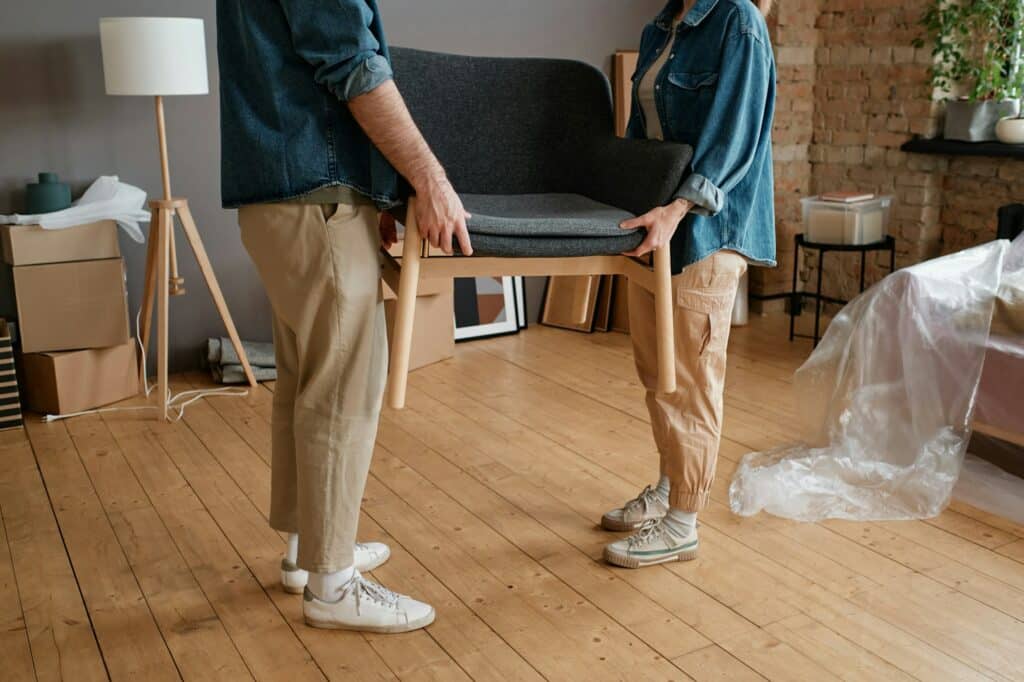Moving furniture can be daunting, whether relocating to a new home, rearranging your current space, or simply doing a deep clean. The process can be physically taxing and time-consuming, and if not done properly, it can damage your beloved pieces. This guide will walk you through the essential steps on how to properly move furniture, ensuring that both you and your furniture stay safe and intact.
Planning and Preparation

Assess Your Furniture
Before you begin the physical act of moving furniture, take some time to assess what you have. Determine the size, weight, and fragility of each piece. This will help you figure out what tools and assistance you’ll need. For instance, large and heavy items like sofas and armoires may require more people to help, while smaller, lighter pieces can be moved more easily.
Measure Doorways and Hallways
One of the most common problems when you move furniture is realizing it doesn’t fit through doorways or hallways. Measure the dimensions of your furniture and compare them with the dimensions of the spaces you’ll need to move through. This simple step can save you from a lot of frustration and potential damage to your furniture or walls.
Gather the Right Tools and Supplies
Having the right tools on hand is crucial for a smooth moving process. Here’s a list of supplies you might need:
- Furniture sliders: These allow you to move heavy furniture across floors without damaging them.
- Moving blankets and pads: Protect your furniture from scratches and dents during the move.
- Dollies: A furniture dolly can make moving heavy items much easier and safer.
- Straps and ropes: These can help secure furniture during transport.
- Disassembly tools: Wrenches, screwdrivers, and Allen keys for disassembling furniture that’s too large or awkward to move in one piece.
Techniques for Moving Furniture Safely

How to Properly Lift Furniture
Lifting heavy furniture improperly is one of the quickest ways to injure yourself. Always remember to lift with your legs, not your back. Bend at your knees, keep your back straight, and use the strength of your legs to lift. Avoid twisting your body when carrying heavy items, as this can cause strain on your back. If possible, always lift and move furniture with a partner.
Use Furniture Sliders
Furniture sliders are a lifesaver when moving heavy furniture across hardwood, tile, or carpeted floors. Place a slider under each leg or corner of the furniture piece. Then, gently push the furniture across the floor. This method helps prevent scratches on your floors and reduces the physical effort needed to move heavy items.
Disassemble When Possible
Disassembling furniture can make the moving process much easier. Remove legs, shelves, and any other detachable parts. This will make the pieces lighter and easier to handle. Keep all screws, bolts, and small parts in labeled bags so you can easily reassemble everything once you reach your destination.
Utilize a Dolly for Heavy Items
A furniture dolly is essential for moving heavy or bulky items like refrigerators, washing machines, or large dressers. To use a dolly, tilt the furniture piece slightly and slide the dolly underneath. Secure the furniture with straps, then carefully roll the dolly to your desired location.
Protecting Your Furniture During the Move

Wrap Furniture in Moving Blankets
Wrap your furniture in moving blankets or pads to prevent scratches, dents, and other damage. Secure the blankets with straps or tape to keep them in place during the move. For particularly fragile items, you may also want to add an extra layer of protection by wrapping them in plastic.
Use Corner Protectors
Corners are particularly vulnerable to damage when moving furniture. Use corner protectors on tables, desks, and other pieces with sharp edges to help prevent chips, scratches, and dents on the furniture and the walls.
Secure Loose Parts
Secure any loose parts, like drawers or doors, before you move furniture. You can use tape or rope to keep them from swinging open during the move, which could cause damage or injury.
Moving Furniture Through Narrow Spaces

Remove Doors if Necessary
If your furniture is too large to fit through a doorway, you may need to remove the door from its hinges. This simple trick can provide the extra space needed to move large items without damaging the furniture or the doorframe.
Tilt and Pivot Larger Pieces
For particularly large pieces of furniture, tilting and pivoting can help you navigate narrow hallways and tight corners. Start by tilting the piece on its side, then slowly rotating it as you move through the space. This method requires coordination and teamwork, so be sure to have a partner assist you.
Consider Dismantling
If tilting and pivoting doesn’t work, consider dismantling the furniture piece entirely. This might involve removing arms from a sofa, disassembling a bed frame, or detaching shelves from a bookcase. Dismantling can make moving through tight spaces much easier and prevent damage to both the furniture and the surrounding environment.
Moving Furniture Up and Down Stairs

Use a Hand Truck for Stairs
A hand truck can be a great tool for moving smaller pieces of furniture up and down stairs. Simply place the furniture on the hand truck, secure it with straps, and carefully roll it up or down the stairs. Ensure someone spots you, especially when going downstairs, to prevent accidents.
Team Lift for Larger Items
For larger pieces of furniture, a team lift is often the safest and most effective method. Place one person on each end of the furniture piece and lift together, keeping the weight evenly distributed. Take your time and communicate with your partner to ensure a smooth and safe move.
Protect Your Stairs
Moving heavy furniture up and down can damage stairs. Consider laying down moving blankets or cardboard along the path to protect them. This will help prevent scratches, dents, and other damage to your stairs.
Ready to Move?
Moving furniture can be challenging, but with the right preparation, tools, and techniques, you can do it safely and efficiently. Whether moving to a new home or simply rearranging your current space, following these steps will help ensure that your furniture stays in great condition and that you avoid any unnecessary stress or injury.
However, if the process seems overwhelming or you prefer to leave it to the professionals, consider contacting Regency Moving. Their experienced team can handle all aspects of your move, from packing to transporting your furniture safely and efficiently. With Regency Moving, you can rest assured that your belongings are in the good hands of furniture movers.



